
AmSteel®-Blue: Stronger and lighter than wire.
AmSteel-Blue Synthetic Rope is an excellent alternative to steel winch cables! AmSteel-Blue winch lines and rope extensions are very durable with extremely low stretch, have superior flex fatigue and are wear resistant. Size-for-size, it is the same strength as steel - yet it floats in water! This Amsteel-Blue rope is a torque-free, 12-strand single braid that yields the maximum in strength-to-weight ratio. When compared to steel cables, AmSteel-Blue Winch Lines are a fraction of the weight and have extremely limited stretching - only 3%. The use of this recovery rope will drastically cut down on the overall weight of any truck - especially heavy duty rotator wreckers which can have up to 6 winches. Also, just think about how much easier the handling of the synthetic Amsteel-Blue Rope verses steel cables will be for your operators in the field.

AmSteel®-Blue Synthetic Winch Line usage in the tow industry
Rollback Car Carrier Application

AmSteel-Blue synthetic rope from Zip's is a great alternative to steel cable on rollback car carriers. Amsteel-Blue is much easier to handle and is "torque neutral" meaning it won't twist - so a swivel hook is not neccessary. Just as strong as steel winch cables, AmSteel-Blue rope is extremely lightweight, abrasion resistant, and is great for water recoveries because it floats on water! If you do a lot of recovery work with your rollback - then buy a 100ft Amsteel Blue Rope Extension from Zip's. When the job is done, simply wrap it up and throw it in your toolbox - it's that easy! When installing Amsteel Blue, it is recommended to remove the winch tensioner.
Heavy Duty Wrecker Application

If you're tired of lugging your 3/4" steel cables into the ditch then convert to Amsteel-Blue Synthetic Winch Lines from Zip's! An excellent alternative to steel winch cables, AmSteel-Blue is a fraction of the weight of steel cables with similar elongation to wire rope, is highly flex-fatigue resistant and is equally strong as steel cables! Also, wrapping Amsteel-Blue is a synch when compared to steel cables. The winch tensioner is not needed and you don't need to worry about bird nesting or the required training of steel cables. Convert to Amsteel-Blue Rope on your heavy duty tow truck or rotator today and never look back!
6 AmSteel®-Blue Configurations
AmSteel®-Blue Synthetic Winch Lines w/ Open Thimble | 5/16"-1/2"
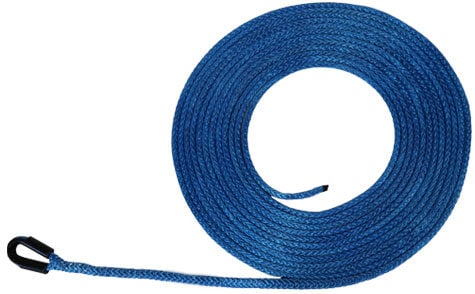
Convert your winch line to AmSteel-Blue synthetics for a better, lightweight, wire rope replacement! This rope comes with an open thimble that will protect the rope from contacting with the load it is hoisting. The thimble will assist in rigging applications as the smaller rope diameter makes this perfect for flat beds, rollbacks or car carriers. Buy Now!
AmSteel®-Blue Synthetic Winch Lines w/ Self-Locking Hook | 5/16" - 1/2"
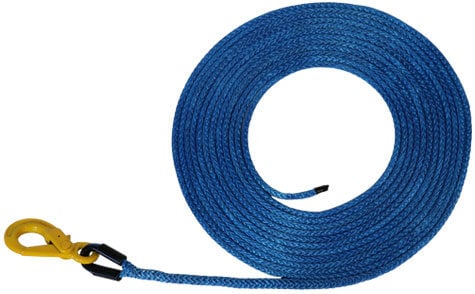
AmSteel-Blue Synthetic Rope will work well as a winch line on tow trucks during any rigging, recovery or other situation found on the job. This rope is smaller in diameter and will pair well with any flat bed, rollback or car carrier. The self-locking hook will ensure safe travels for your heavy loads, cargo or vehicles. Buy Now!
AmSteel®-Blue Synthetic Rope Extensions w/ Self-Locking Hook | 5/16" - 1/2"
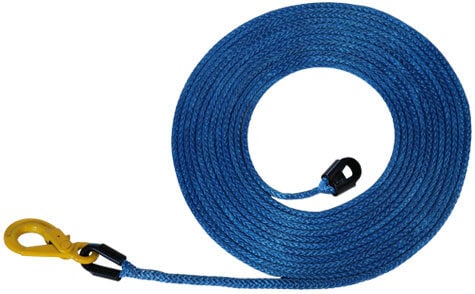
Extend your winch line rope easily for extra length in recovery work with AmSteel-Blue Synthetic Rope. This rope is smaller in diameter and will pair well with any flat bed, rollback or car carrier. The self-locking hook will ensure safe travels for your heavy loads, cargo or vehicles. Buy Now!
AmSteel®-Blue Synthetic Winch Lines w/ Closed Thimble | 9/16" - 7/8"
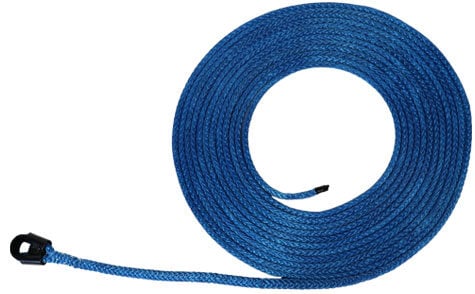
The AmSteel-Blue Winch Line with a closed thimble helps towing operators get a safer connection when performing recovery scenarios. The tubular design of the closed thimble creates a high-strength connection that protects the rope and maintains the proper bending radius when interlocked to hardware. A thimble will assist you in rigging applications while on the job. The thickness of this rope is safe to use on heavy duty wreckers, industrial carriers and more! Buy Now!
AmSteel®-Blue Synthetic Winch Lines w/ Self-Locking Hook | 9/16" - 7/8"
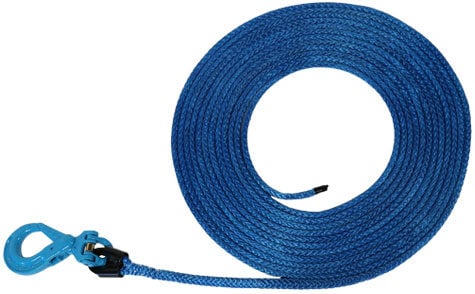
Choose a self-locking hook on your AmSteel-Blue synthetic winch line to ensure the hook will not open when being used with a heavy load. This rope, being a thicker winch line, has an extremely high strength but is lightweight and flexible. It can easily be used with heavy duty wreckers, industrial carriers and more! Buy Now!
AmSteel®-Blue Synthetic Rope Extensions w/ Self Locking Hook | 9/16" - 7/8"
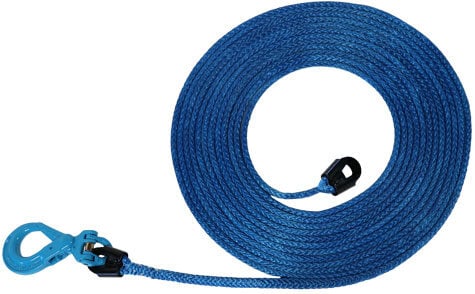
Choose a self-locking hook on your AmSteel-Blue synthetic rope extension to ensure the hook will not open when under heavy load. This rope, being a thicker winch line, has an extremely high strength but is lightweight and flexible. It can easily be used with heavy duty wreckers, industrial carriers and more! Buy Now!
AmSteel-Blue Color Options
Blue (Standard)

Green

Gray

Red

Orange

Yellow

Black

AmSteel-Blue Color Options
Dyneema®
Specific Gravity:
0.98 (floats)
Elastic Elongation:
At percent of break strength
10% ..... 0.46%
20% ..... 0.70%
30% ..... 0.96%
Applications:
- Pulling/stringing lines
- Climbing/rigging accessories
- Winch lines
- Slings
- Lifelines
- Camera control lines
Features:
- Abrasion resistant
- Easy to inspect
- Excellent wear characteristics
- Extremely low stretch
- Flexible
- Floats
- High strength
- Highly flex-fatigue resistant
- Lightweight
- Similar elastic elongation to wire rope
- Torque-free construction
- Wire rope replacement
- Available in 7 colors (Blue standard)
- Many more dimensions and custom lengths available
Size Options and Weight Limits

Instructions to Install Synthetic Rope on a Winch
1. Remove the Cable Tensioner From the Winch Assembly. Unlike steel cable, synthetic rope has no memory and is torque-neutral so pressure applied by a winch tensioner is not necessary to properly hold the rope around the winch drum. Also, by removing the tensioner you eliminate unnecessary friction on the rope - extending the life of the rope.
2. Inspect the Path of the Winch Line for Rough Areas or Sharp Edges. If any rough areas on the winch drum, roller guide, sheaves, blocks or guides are found simply grind and/or sand down until a smooth surface is achieved.
3. Remove the Rope From Packaging and Prepare for Installation. Make sure the rope is removed from packaging and installed in a clean area free from any grinding, welding, dirt, gravel or debris.
4. Install the Rope onto the Winch Drum. Attach the rope to the drum according to the winch manufacturers specifications. Wrap the first 5 wraps under light tension. Hand tension of 150-250 lbs is sufficient.
5. Power Wrap the Remaining Rope Under Load. For proper and safe working function, it is recommended to wrap the rope under load - as close to or equal to the Working Load Limit (WLL) of the rope. The use of a digital load meter is recommended to maintain proper tension while wrapping.
NOTE: Avoid allowing synthetic rope to contact rough or sharp edges while winching or lifting. Consider using an appropriate chafe guard for protection in areas of concern. When winching with synthetic rope, do NOT winch under load with less than 8 wraps on the winch drum.
Understanding Abrasion
There are two types of abrasion: internal abrasion caused by the relative movement of internal and external yarns, and external abrasion caused by contact with external surfaces. An unprotected rope moving over a rough surface, such as a poorly maintained chock can be subjected to both. Upon inspection, it’s easy to see that the external strands are abraded by a rough surface: often fibers can be left behind on the surface that caused the abrasion, and the surface of the rope readily shows abraded yarns. The same rough surfaces can also cause internal abrasion due to the movement of the internal strands relative to each other. When the rope’s surface strands pass over rough surfaces, they are slowed relative to the strands next to them, causing friction. Heat is created from friction – and heat is among the biggest enemies of synthetic ropes.

Inspection and Retirement Checklist
Any rope that has been in use for any period of time will show normal wear and tear. Some characteristics of a used rope will not reduce strength while others will. Below we have defined normal conditions that should be inspected on a regular basis.
If upon inspection you find any of these conditions, you must consider the following before deciding to repair or retire it:
- The length of the rope,
- The time it has been in service,
- The type of work it does,
- Where the damage is, and
- The extent of the damage
In general, it is recommended to:
- Repair the rope if the observed damage is in localized areas and the application permits.
- Retire the rope if the damage is over extended areas
Cut strands

Repair or Retire
What:
- Two or more cut strands in proximity
Cause:
- Abrasion
- Sharp edges and surfaces
- Cyclic tension wear
Corrective Action:
If possible, remove affected section and resplice with a standard end-for-end splice. If resplicing is not possible, retire the rope.
Compression

Not permanent – Repair
What:
- Visible sheen
- Stiffness reduced by flexing the rope
- Not to be confused with melting
- Often seen on winch drums
Cause:
- Fiber molding itself to the contact surface under a radial load
Corrective Action:
Flex the rope to remove compression.
Pulled Strand

Not permanent – Repair
What:
- Strand pulled away from the rest of the rope
- Is not cut of otherwise damaged
Cause:
- Snagging on equipment or surfaces
Corrective Action:
Work back into the rope.
Melted or Glazed Fiber

Repair or Retire
What:
- Fused fibers
- Visibly charred and melted fibers, yarns and/or strands
- Extreme stiffness
- Unchanged by flexing
Cause:
- Exposure to excessive heat, shock load or a sustained high load
Corrective Action:
If possible, remove affected section and resplice with a standard end-for-end splice. If resplicing is not possible, retire the rope.
Discoloration/Degradation

Repair or Retire
What:
- Fused fibers
- Brittle fibers
- Stiffness
Cause:
- Chemical contamination
Corrective Action:
If possible, remove affected section and resplice with a standard end-for-end splice. If resplicing is not possible, retire the rope.
Inconsistent Diameter

Repair or Retire
What:
- Flat areas
- Lumps and bumps
Cause:
- Shock loading
- Broken internal strands
Corrective Action:
If possible, remove affected section and resplice with a standard end-for-end splice. If resplicing is not possible, retire the rope.
Abrasion

Repair or Retire
What:
- Broken filaments and yarns
Cause:
- Abrasion
- Sharp edges and surfaces
- Cyclic tension wear
Corrective Action:
Consult abrasion images* and rate internal/external abrasion level of rope. Evaluate rope based on its most damaged section.
Minimal strength loss (continue use)
Significant strength loss (consult Samson)
Severe strength loss (retire rope)
*Refer to "Understanding Abrasion" visual above







